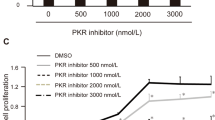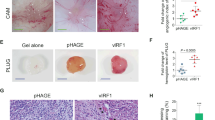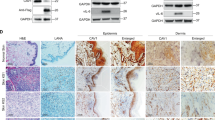Abstract
In this study, we addressed the hypothesis that transcriptional suppression of erythroblastosis virus E26 oncogene homolog 1 (ETS-1) is an efficient therapeutic approach to pancreatic adenocarcinoma by investigating the effect of ETS-1 suppression in human pancreatic cancer cells. We accomplished this by using an adenoviral vector encoding only the DNA-binding domain of wild-type ETS-1 (ETS-1 dominant negative, ETS-1-DN). ETS-1-DN decreases ETS-1-binding by competing for its binding to DNA. Adenoviral-mediated transfer of ETS-1-DN (adenoviral ETS-1-DN construct, AdETS-1-DN) into pancreatic tumor cell lines did not affect their proliferation rate in vitro but did significantly inhibit their in vivo growth in nude mice. Furthermore, to test the efficacy of ETS-1-DN in vivo, we injected the AdETS-1-DN into established human pancreatic adenocarcinomas grown in nude mice. This treatment significantly reduced tumor size as compared to saline injection, without any detectable side effects. Microvessel density in mouse xenografts displayed significantly lower values in tumors in which ETS-1 was downregulated. In addition, expression of the ETS-1-DN in the pancreatic cancer cells resulted in downregulation of urokinase-type plasminogen activator (u-PA) and metalloproteinase-1 (MMP-1) expression. Taken together, these data suggest that transcriptional inactivation of ETS-1 is able to significantly affect angiogenesis and growth of pancreatic cancer. This effect may be due in part to downregulation of MMP-1 and u-PA expression. Our results suggest that ETS-1-DN is a promising candidate for antiangiogenic gene therapy in pancreatic cancer.
This is a preview of subscription content, access via your institution
Access options
Subscribe to this journal
Receive 12 print issues and online access
$259.00 per year
only $21.58 per issue
Buy this article
- Purchase on Springer Link
- Instant access to full article PDF
Prices may be subject to local taxes which are calculated during checkout





Similar content being viewed by others
Abbreviations
- AdETS-1-DN:
-
adenoviral ETS-1-DN construct
- EBD:
-
ETS-1 DNA-binding domain
- ETS-1:
-
erythroblastosis virus E26 oncogene homolog 1
- ETS-1-DN:
-
ETS-1 dominant negative
References
Jemal A, Siegel R, Ward E, Murray T, Xu J, Thun MJ . Cancer statistics, 2007. CA Cancer J Clin 2007; 57: 43–66.
Parker SL, Tong T, Bolden S, Wingo PA . Cancer statistics, 1997. CA Cancer J Clin 1997; 47: 5–27.
Ariyama J, Suyama M, Ogawa K, Ikari T, Nagaiwa J, Fujii D et al. The detection and prognosis of small pancreatic carcinoma. Int J Pancreatol 1990; 7: 37–47.
Sandler A, Gray R, Perry MC, Brahmer J, Schiller JH, Dowlati A et al. Paclitaxel-carboplatin alone or with bevacizumab for non-small-cell lung cancer. N Engl J Med 2006; 355: 2542–2550.
Hurwitz H, Fehrenbacher L, Novotny W, Cartwright T, Hainsworth J, Heim W et al. Bevacizumab plus irinotecan, fluorouracil, and leucovorin for metastatic colorectal cancer. N Engl J Med 2004; 350: 2335–2342.
Duda DG, Sunamura M, Lefter LP, Furukawa T, Yokoyama T, Yatsuoka T et al. Restoration of SMAD4 by gene therapy reverses the invasive phenotype in pancreatic adenocarcinoma cells. Oncogene 2003; 22: 6857–6864.
Nelson AR, Fingleton B, Rothenberg ML, Matrisian LM . Matrix metalloproteinases: biologic activity and clinical implications. J Clin Oncol 2000; 18: 1135–1149.
Kitamura T, Taketo MM . Keeping out the bad guys: gateway to cellular target therapy. Cancer Res 2007; 67: 10099–10102.
Leprince D, Gegonne A, Coll J, de Taisne C, Schneeberger A, Lagrou C et al. A putative second cell-derived oncogene of the avian leukaemia retrovirus E26. Nature 1983; 306: 395–397.
Nunn MF, Seeburg PH, Moscovici C, Duesberg PH . Tripartite structure of the avian erythroblastosis virus E26 transforming gene. Nature 1983; 306: 391–395.
Ghysdael J, Boureux A . The ETS family of transcriptional regulators. In: Karin M (ed). Oncogenes as Transcriptional Regulators. Birkhauser: Basel, 1997.
Oda N, Abe M, Sato Y . ETS-1 converts endothelial cells to the angiogenic phenotype by inducing the expression of matrix metalloproteinases and integrin beta3. J Cell Physiol 1999; 178: 121–132.
Lelievre E, Mattot V, Huber P, Vandenbunder B, Soncin F . ETS1 lowers capillary endothelial cell density at confluence and induces the expression of VE-cadherin. Oncogene 2000; 19: 2438–2446.
Sementchenko VI, Watson DK . Ets target genes: past, present and future. Oncogene 2000; 19: 6533–6548.
Nakayama T, Ito M, Ohtsuru A, Naito S, Nakashima M, Fagin JA et al. Expression of the Ets-1 proto-oncogene in human gastric carcinoma: correlation with tumor invasion. Am J Pathol 1996; 149: 1931–1939.
Nakayama T, Ito M, Ohtsuru A, Naito S, Nakashima M, Sekine I . Expression of the ets-1 proto-oncogene in human thyroid tumor. Mod Pathol 1999; 12: 61–68.
Ito T, Nakayama T, Ito M, Naito S, Kanematsu T, Sekine I . Expression of the ets-1 proto-oncogene in human pancreatic carcinoma. Mod Pathol 1998; 11: 209–215.
Mattot V, Vercamer C, Soncin F, Calmels T, Huguet C, Fafeur V et al. Constitutive expression of the DNA-binding domain of Ets1 increases endothelial cell adhesion and stimulates their organization into capillary-like structures. Oncogene 2000; 19: 762–772.
Nakano T, Abe M, Tanaka K, Shineha R, Satomi S, Sato Y . Angiogenesis inhibition by transdominant mutant Ets-1. J Cell Physiol 2000; 184: 255–262.
Kita D, Takino T, Nakada M, Takahashi T, Yamashita J, Sato H . Expression of dominant-negative form of Ets-1 suppresses fibronectin-stimulated cell adhesion and migration through down-regulation of integrin alpha5 expression in U251 glioma cell line. Cancer Res 2001; 61: 7985–7991.
Sun C, Yamato T, Furukawa T, Ohnishi Y, Kijima H, Horii A . Characterization of the mutations of the K-ras, p53, p16, and SMAD4 genes in 15 human pancreatic cancer cell lines. Oncol Rep 2001; 8: 89–92.
Furukawa T, Duguid WP, Rosenberg L, Viallet J, Galloway DA, Tsao MS . Long-term culture and immortalization of epithelial cells from normal adult human pancreatic ducts transfected by the E6E7 gene of human papilloma virus 16. Am J Pathol 1996; 148: 1763–1770.
Fujii M, Takeda K, Imamura T, Aoki H, Sampath TK, Enomoto S et al. Roles of bone morphogenetic protein type I receptors and Smad proteins in osteoblast and chondroblast differentiation. Mol Biol Cell 1999; 10: 3801–3813.
Jiao S, Cheng L, Wolff JA, Yang NS . Particle bombardment-mediated gene transfer and expression in rat brain tissues. Biotechnology (N Y) 1993; 11: 497–502.
Mori Y, Shiwaku H, Fukushige S, Wakatsuki S, Sato M, Nukiwa T et al. Alternative splicing of hMSH2 in normal human tissues. Hum Genet 1997; 99: 590–595.
Sunamura M, Lefter LP, Duda DG, Morita R, Inoue H, Yokoyama T et al. The role of chromosome 18 abnormalities in the progression of pancreatic adenocarcinoma. Pancreas 2004; 28: 311–316.
Kondo E, Furukawa T, Yoshinaga K, Kijima H, Semba S, Yatsuoka T et al. Not hMSH2 but hMLH1 is frequently silenced by hypermethylation in endometrial cancer but rarely silenced in pancreatic cancer with microsatellite instability. Int J Oncol 2000; 17: 535–541.
Kondo E, Horii A, Fukushige S . The human PMS2L proteins do not interact with hMLH1, a major DNA mismatch repair protein. J Biochem 1999; 125: 818–825.
Attiga FA, Fernandez PM, Weeraratna AT, Manyak MJ, Patierno SR . Inhibitors of prostaglandin synthesis inhibit human prostate tumor cell invasiveness and reduce the release of matrix metalloproteinases. Cancer Res 2000; 60: 4629–4637.
Iwasaka C, Tanaka K, Abe M, Sato Y . Ets-1 regulates angiogenesis by inducing the expression of urokinase-type plasminogen activator and matrix metalloproteinase-1 and the migration of vascular endothelial cells. J Cell Physiol 1996; 169: 522–531.
Teruyama K, Abe M, Nakano T, Iwasaka-Yagi C, Takahashi S, Yamada S et al. Role of transcription factor Ets-1 in the apoptosis of human vascular endothelial cells. J Cell Physiol 2001; 188: 243–252.
van Golen KL, Wu ZF, Qiao XT, Bao LW, Merajver SD . RhoC GTPase, a novel transforming oncogene for human mammary epithelial cells that partially recapitulates the inflammatory breast cancer phenotype. Cancer Res 2000; 60: 5832–5838.
Lefter LP, Sunamura M, Furukawa T, Takeda K, Kotobuki N, Oshimura M et al. Inserting chromosome 18 into pancreatic cancer cells switches them to a dormant metastatic phenotype. Clin Cancer Res 2003; 9: 5044–5052.
Zhu Z, Kleeff J, Kayed H, Wang L, Korc M, Buchler MW et al. Nerve growth factor and enhancement of proliferation, invasion, and tumorigenicity of pancreatic cancer cells. Mol Carcinog 2002; 35: 138–147.
Khorana AA, Ahrendt SA, Ryan CK, Francis CW, Hruban RH, Hu YC et al. Tissue factor expression, angiogenesis, and thrombosis in pancreatic cancer. Clin Cancer Res 2007; 13: 2870–2875.
Liao F, Li Y, O'Connor W, Zanetta L, Bassi R, Santiago A et al. Monoclonal antibody to vascular endothelial-cadherin is a potent inhibitor of angiogenesis, tumor growth, and metastasis. Cancer Res 2000; 60: 6805–6810.
Sun Y, Wenger L, Rutter JL, Brinckerhoff CE, Cheung HS . p53 down-regulates human matrix metalloproteinase-1 (Collagenase-1) gene expression. J Biol Chem 1999; 274: 11535–11540.
Thant AA, Sein TT, Liu E, Machida K, Kikkawa F, Koike T et al. Ras pathway is required for the activation of MMP-2 secretion and for the invasion of src-transformed 3Y1. Oncogene 1999; 18: 6555–6563.
Lelievre E, Lionneton F, Soncin F, Vandenbunder B . The Ets family contains transcriptional activators and repressors involved in angiogenesis. Int J Biochem Cell Biol 2001; 33: 391–407.
Crawford HC, Scoggins CR, Washington MK, Matrisian LM, Leach SD . Matrix metalloproteinase-7 is expressed by pancreatic cancer precursors and regulates acinar-to-ductal metaplasia in exocrine pancreas. J Clin Invest 2002; 109: 1437–1444.
Ellenrieder V, Hendler SF, Ruhland C, Boeck W, Adler G, Gress TM . TGF-beta-induced invasiveness of pancreatic cancer cells is mediated by matrix metalloproteinase-2 and the urokinase plasminogen activator system. Int J Cancer 2001; 93: 204–211.
Behrens P, Rothe M, Wellmann A, Krischler J, Wernert N . The Ets-1 transcription factor is up-regulated together with MMP 1 and MMP 9 in the stroma of pre-invasive breast cancer. J Pathol 2001; 194: 43–50.
Nakayama T, Ito M, Ohtsuru A, Naito S, Sekine I . Expression of the ets-1 proto-oncogene in human colorectal carcinoma. Mod Pathol 2001; 14: 415–422.
Tan MH, Nowak NJ, Loor R, Ochi H, Sandberg AA, Lopez C et al. Characterization of a new primary human pancreatic tumor line. Cancer Invest 1986; 4: 15–23.
Yunis AA, Arimura GK, Russin DJ . Human pancreatic carcinoma (MIA PaCa-2) in continuous culture: sensitivity to asparaginase. Int J Cancer 1977; 19: 128–135.
Hotz HG, Reber HA, Hotz B, Yu T, Foitzik T, Buhr HJ et al. An orthotopic nude mouse model for evaluating pathophysiology and therapy of pancreatic cancer. Pancreas 2003; 26: e89–e98.
Davidson B, Reich R, Goldberg I, Gotlieb WH, Kopolovic J, Berner A et al. Ets-1 messenger RNA expression is a novel marker of poor survival in ovarian carcinoma. Clin Cancer Res 2001; 7: 551–557.
Ozaki I, Mizuta T, Zhao G, Yotsumoto H, Hara T, Kajihara S et al. Involvement of the Ets-1 gene in overexpression of matrilysin in human hepatocellular carcinoma. Cancer Res 2000; 60: 6519–6525.
Zetter BR . Angiogenesis and tumor metastasis. Annu Rev Med 1998; 49: 407–424.
Oikawa T, Yamada T . Molecular biology of the Ets family of transcription factors. Gene 2003; 303: 11–34.
Lelievre E, Lionneton F, Mattot V, Spruyt N, Soncin F . Ets-1 regulates fli-1 expression in endothelial cells. Identification of ETS binding sites in the fli-1 gene promoter. J Biol Chem 2002; 277: 25143–25151.
Acknowledgements
This work was supported by The Romanian National Authority for Scientific Research—CEEX 62 and 117 research grants—and the Japanese Ministries of Education, Culture, Sport, Science, and Technology.
Author information
Authors and Affiliations
Corresponding author
Additional information
Some data included in this article were presented at the 17th World Congress of the International Association of Surgeons, Gastroenterologists and Oncologists in Bucharest, Romania, on 5–8 September 2007.
Rights and permissions
About this article
Cite this article
Lefter, L., Dima, S., Sunamura, M. et al. Transcriptional silencing of ETS-1 efficiently suppresses angiogenesis of pancreatic cancer. Cancer Gene Ther 16, 137–148 (2009). https://doi.org/10.1038/cgt.2008.65
Received:
Revised:
Accepted:
Published:
Issue Date:
DOI: https://doi.org/10.1038/cgt.2008.65



